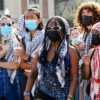There were 13 Islamist-inspired terror attacks and plots within the United States in 2015—the greatest number in any year since Sept. 11, 2001. And more than the years 2012, 2013, and 2014 combined.
This increase reminds us that Congress and the Obama administration’s leadership on the matter remains lackluster as we near the end of the president’s term.
Most by now know the events that happened in San Bernardino, Calif., and perhaps even in Garland, Texas, and the most recent plot in Rochester, New York. But it’s important to remember that there were also plots that targeted military bases and those in uniform and envisioned pipe bomb attacks in New York, attacks on members of Congress, and attacks on law enforcement.
The inspiration of international Islamist terrorist organizations has continued over the past 14 years, but its greatest impact is when it reaches the ears of those within the U.S. Almost 80 percent of the 76 attacks or plots since 9/11 were committed by self-radicalized U.S. citizens.
But not since the rise of ISIS in 2013 has the misguided ideology of Islam been this digitized. The majority of attacks and plots since 2013 have in some degree been inspired by ISIS and its belief that it is fighting an apocalyptic war.
There has been a noticeable increase in not just attacks and plots, but also the financing or material support for ISIS, or attempts to travel abroad as a foreign fighter.
This brings us to two areas of concern: stopping the spread of radical messaging by ISIS and other Islamist terrorist organizations like al-Qaeda and al-Shabaab and stopping the flow of foreign fighters.
Attempting to counter radical messaging online is more a war of attrition. Eventually, groups like ISIS will need to be dealt with face to face—this is where the administration has been the most uninspiring. Websites and videos can be taken down and put back up within hours, which is why it’s important for communities to counter terrorists’ radical ideals.
For ISIS, Syria and Iraq are its stronghold. While the U.S. and foreign nations continue airstrikes, foreign fighters from the U.S., Europe, northern Africa, and numerous other countries continue to add numbers to ISIS forces.
This needs to be addressed as well by U.S. leadership with the help of international allies, partners, and the greater intelligence community as ISIS continues to gain recruits. The U.S. must remain vigilant, as the threat of terrorism continues to exist.




























